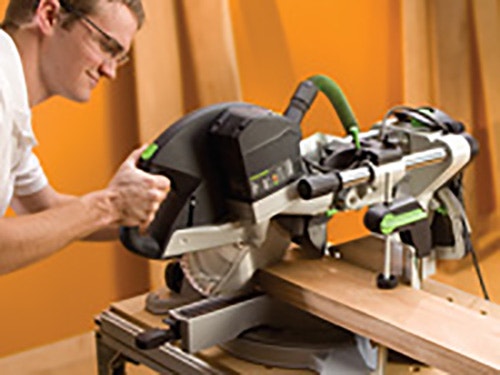Miter Saw Kickback?
Many of us are familiar with the unnerving experience of having a sliding miter saw blade bind in piece of wood; in the middle of a cut, you feel a sudden, violent jerking backward of the motor and blade unit. Such an event seldom leads to serious injury (provided a few common sense safety rules have been followed) but nevertheless can leave a person with a desire to move on to something safer - like sanding or sweeping the floor.
Most of what you'll read and hear on the subject of kickback, however, relates to "machines" that have the power and potential to hurl a good-sized piece of material in the general direction of the woodworker. This is a much more dire form of woodworking mishap.
Woodworker's Journal's Rob Johnstone states:
"'True' kickback is a situation where a rotating saw blade (or cutter of some sort) grabs or binds to a piece of material and throws or 'kicks it back' opposite the direction that it is being pushed (i.e., towards the user). It is prione: marily a problem with a table saw (or in some cases a table-mounted router or shaper). This is very dangerous, as it can pull your fingers through the saw blade or even impale you with the material that is being thrown back at you.
"Where you are moving the saw through the material with a radial arm saw or sliding miter saw as you described, if the material should bind the saw blade - with or without a stop block - the saw would be impelled toward the user. This is startling, but in most cases quite manageable. The material will be pushed or thrown away from the user (toward the fence). If the material is tight to the fence when you start your cut, then with a chop saw or the like, it is really not a dangerous thing. You must keep your off hand out of the path of the saw in any case, as is only common sense."

Even if you do follow basic miter saw safety rules - keeping your free hand well out of the path of the blade; wearing safety equipment; making sure any angle settings are securely locked in; keeping the material up tight against the fence and bed of the tool, etc.* - you may encounter an occasional surprise. The most common is the one described above, where the blade gets stuck in the material and, in the case of a sliding saw, is propelled toward the user.
What causes this? This type of kickback happens when the kerf closes in on the blade and "grabs" it. It happens frequently when sawing long, wide boards near the middle. When lumber isn't perfectly straight and flat (and it never truly is) it can't be held in firm contact with the fence and bed of the saw at every point. As the cut proceeds and the wood moves into closer contact with the fence and/or bed, the kerf changes shape and can impinge on the path of the blade. When cutting long, wide stock on a sliding miter saw, some woodworkers like to start by making a partial chop cut near the fence side of the blade. Doing so helps soften the effects of any binding that takes place.
Other factors contribute to blade binding, including one or two that are entirely preventable. Wet wood or wood with a high pitch content is more "sticky" and can be more grab-prone. A dull or inappropriate blade will also have more of a tendency to bind. On a sliding miter saw, a dull blade with an aggressive hook angle and too few teeth is a recipe for jagged cuts, short bits of cutoff ricocheting hither and yon, and a generally unpleasant sawing experience at the very least. A quality blade designed for use on a slider (such as Freud's LU91R Sliding Compound Miter Saw Blade) will not only help cut down on binding, but will also make a world of difference in quality of cut the saw delivers.
You should also check to make sure the saw is functioning properly. The blade needs follow a perfectly straight path throughout the cut to avoid rubbing up against the kerf. Make sure that bevel and miter settings are holding fast, that the blade is on tight, and that there's no appreciable slop in any of the working parts.
Another unpleasant miter saw event happens when the blade catches the edge of a piece of cutoff and fires it across the shop. Occurring most often with very small pieces of stock, this type of "kickback" is rarely puts the operator in great physical danger (as long as appropriate safety equipment is in use). But it is startling, and can be very annoying when the sawn-off projectile - which can be extremely difficult to find - is the part you need.
A good blade and a correctly functioning saw are the best defense against flying cutoff. It's also advisable to use a moderate slicing stroke instead of slamming though the wood as fast as you can (chop saw is a name, after all, not an instruction). Another trick is to let the blade come to a complete stop before lifting it up past the stock. If everything else is in order, doing so should leave even tiny cut off ends lying right next to the blade.
NOTE: * Please read your saw's owner's manual for a more complete list of safety rules.
Keep the inspiration coming!
Subscribe to our newsletter for more woodworking tips and tricks


